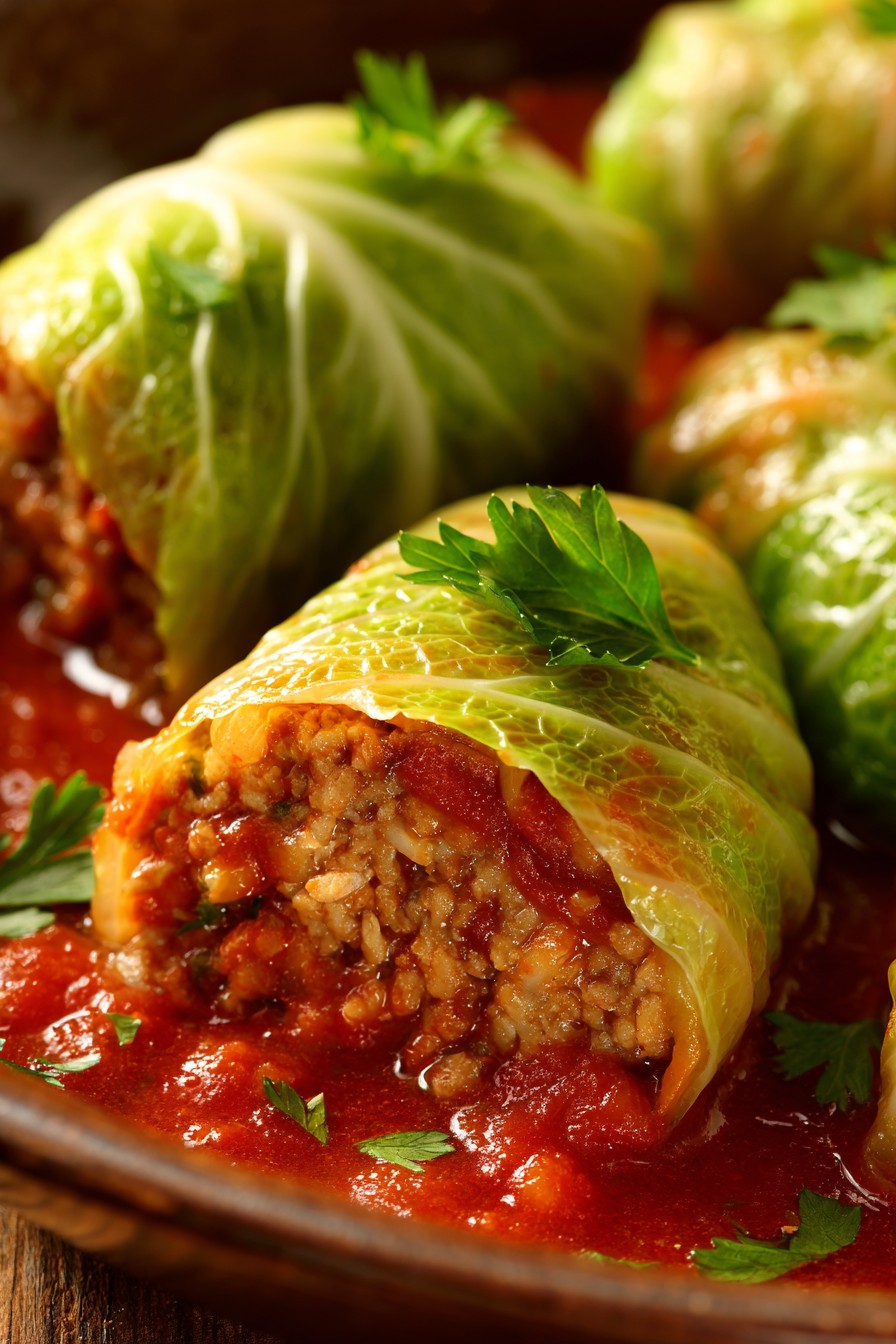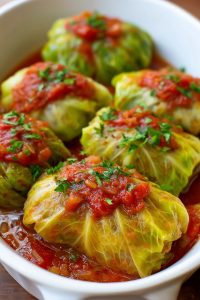Traditional Eastern European comfort food gets a nutritious makeover with this health-conscious halupki recipe that maintains authentic flavors while boosting nutritional value. These cabbage rolls represent the perfect marriage of cultural heritage and modern wellness principles.
Why This Recipe Works
- Using lean ground turkey instead of traditional pork or beef significantly reduces saturated fat content while maintaining protein levels essential for muscle maintenance and metabolic health
- Whole grain brown rice provides complex carbohydrates and additional fiber that supports digestive health and provides sustained energy release throughout the day
- Fresh cabbage leaves offer abundant vitamins C and K along with antioxidants that support immune function and inflammation reduction
- The tomato-based sauce delivers lycopene, a powerful antioxidant linked to reduced risk of certain cancers and improved heart health
- Baking instead of frying preserves nutrients while achieving the perfect tender texture without excess oil or fat
Ingredients
- 1 large head green cabbage (about 3 pounds), core removed
- 1 pound lean ground turkey (93% lean)
- 1 cup cooked brown rice, cooled completely
- 1 medium yellow onion, finely diced
- 2 cloves garlic, minced
- 1 large egg, lightly beaten
- 2 tablespoons fresh parsley, chopped
- 1 teaspoon dried thyme
- 1/2 teaspoon smoked paprika
- 1/4 teaspoon ground black pepper
- 1/2 teaspoon sea salt
- 2 cups crushed tomatoes (no salt added)
- 1 cup low-sodium vegetable broth
- 2 tablespoons tomato paste
- 1 tablespoon apple cider vinegar
- 1 teaspoon honey or maple syrup
- 1 bay leaf
Equipment Needed
- Large stockpot (8-quart or larger)
- Mixing bowls (various sizes)
- 9×13 inch baking dish
- Sharp knife and cutting board
- Measuring cups and spoons
- Wooden spoon or spatula
- Kitchen twine or toothpicks (optional)
- Aluminum foil
Instructions

Preparing the Cabbage Leaves
Begin by carefully removing the core from your cabbage using a sharp paring knife, creating a 2-inch deep cavity. Fill your large stockpot with about 4 inches of water and bring to a rolling boil over high heat. Gently lower the whole cabbage head into the boiling water, core side down, and cook for 8-10 minutes until the outer leaves become pliable and slightly translucent. Using tongs, carefully peel away the softened outer leaves and transfer them to a colander to drain and cool. Return the cabbage to boiling water as needed to soften inner leaves, repeating until you have 12-16 large, intact leaves. For nutritional optimization, reserve the cabbage cooking water – it contains water-soluble vitamins that can be used in soups or as a nutrient-rich base for other dishes. Pat each leaf dry with paper towels and use a paring knife to carefully shave down the thick central vein to ensure even rolling and cooking.
Creating the Filling Mixture
Assembling the Cabbage Rolls
Lay each prepared cabbage leaf flat on your work surface with the stem end facing you. Place approximately 1/4 cup of the filling mixture in the center of each leaf, about 2 inches from the bottom edge. Fold the bottom edge of the leaf over the filling, then fold in the sides, and roll tightly away from you to create a neat package. The tight rolling ensures even cooking and prevents the filling from drying out during baking. If needed, secure with kitchen twine or toothpicks, though properly rolled cabbage rolls should hold their shape naturally. Arrange the rolls seam-side down in your prepared 9×13 inch baking dish, packing them snugly together to prevent unrolling during cooking. This careful assembly technique preserves the integrity of each roll while allowing for even heat distribution.
Preparing the Sauce and Initial Baking
In a medium bowl, whisk together the crushed tomatoes, low-sodium vegetable broth, tomato paste, apple cider vinegar, honey or maple syrup, and bay leaf until thoroughly combined. The tomato-based sauce provides significant nutritional benefits, particularly lycopene which becomes more bioavailable when cooked and helps combat oxidative stress in the body. Pour the sauce evenly over the arranged cabbage rolls, ensuring each roll is generously coated. The liquid should come about halfway up the sides of the rolls – add additional broth if necessary. Cover the baking dish tightly with aluminum foil and place in a preheated 375°F oven. Bake for 45 minutes, then remove the foil and continue baking for another 15-20 minutes until the tops are lightly browned and the sauce is bubbling vigorously around the edges.
Final Cooking and Resting Period
After the initial baking period, carefully remove the baking dish from the oven and test for doneness by inserting an instant-read thermometer into the center of one roll – it should register at least 165°F to ensure food safety. The cabbage leaves should be tender enough to easily pierce with a fork but still maintain structural integrity. Allow the halupki to rest uncovered for 10-15 minutes before serving – this crucial resting period allows the proteins in the filling to reabsorb moisture and the flavors to meld beautifully. The resting time also brings the dish to a safe serving temperature while allowing the starches in the rice to set properly, resulting in perfect texture and easier serving. Serve warm with additional sauce spooned over the top.
Tips and Tricks
For those following specific dietary protocols, several modifications can enhance this recipe’s nutritional profile. If you’re monitoring sodium intake, consider using no-salt-added tomatoes and reducing or eliminating the added salt – the natural flavors from the vegetables and herbs often provide sufficient seasoning. For a vegetarian version, substitute the ground turkey with a mixture of cooked lentils and mushrooms, which provides similar texture while adding beneficial plant compounds and fiber. When working with the cabbage leaves, if you encounter tears or holes, don’t discard them – layer two imperfect leaves together to create a strong wrapper. For meal prep enthusiasts, these cabbage rolls freeze exceptionally well. Cool completely after baking, then wrap individually in parchment paper before placing in freezer-safe containers. They’ll maintain quality for up to 3 months and can be reheated directly from frozen in a 350°F oven for 25-30 minutes. The cooking liquid from blanching the cabbage contains water-soluble vitamins like vitamin C and B vitamins – rather than discarding it, use it as a nutrient-rich base for soups or stews. When selecting your cabbage, choose heads that feel heavy for their size with crisp, tightly packed leaves – these typically have higher moisture content and better flavor. For those with digestive sensitivities, the fermentation process in traditional sauerkraut-style halupki can be replicated by adding a tablespoon of raw sauerkraut juice to the sauce, introducing beneficial probiotics. If you prefer a thicker sauce, mix one tablespoon of arrowroot powder with two tablespoons of cold water and stir into the sauce during the last 10 minutes of baking. Always allow the filling mixture to rest for 15 minutes after mixing – this allows the rice to absorb moisture and results in a more cohesive filling that’s easier to work with.
Recipe Variations
- Mediterranean-inspired version replaces the turkey with ground lamb and adds 1/4 cup each of chopped kalamata olives and crumbled feta cheese to the filling, while incorporating 1 teaspoon of dried oregano and 1/2 teaspoon of lemon zest into the sauce for bright, complex flavors that align with heart-healthy Mediterranean dietary patterns
- Plant-based adaptation uses a mixture of 2 cups cooked brown lentils, 1/2 cup finely chopped walnuts, and 1/2 cup cooked quinoa instead of ground turkey, providing complete protein through complementary plant sources while delivering additional fiber, antioxidants, and healthy fats that support cardiovascular health and reduce inflammation
- Spicy Southwest twist incorporates 1 tablespoon chili powder, 1 teaspoon ground cumin, and 1/2 teaspoon chipotle powder into the filling mixture, while replacing the tomato sauce with a combination of 1 cup tomato sauce and 1 cup mild green enchilada sauce, offering metabolism-boosting capsaicin from the spices and additional phytonutrients from the tomatillo-based sauce
- Asian-fusion variation substitutes the traditional tomato sauce with a mixture of 1 cup low-sodium vegetable broth, 1/4 cup tamari or coconut aminos, 2 tablespoons rice vinegar, 1 tablespoon sesame oil, and 1 teaspoon grated fresh ginger, while adding 1/2 cup finely shredded carrots and 1/4 cup chopped water chestnuts to the filling for added crunch and additional vitamin A content
- Low-carb option replaces the brown rice with 2 cups riced cauliflower that has been steamed and thoroughly drained, while increasing the ground turkey to 1.5 pounds to maintain protein levels, creating a dish suitable for ketogenic or low-carbohydrate dietary approaches that still delivers substantial micronutrient content from the vegetables
Frequently Asked Questions
Can I prepare halupki ahead of time and refrigerate before baking?
Absolutely, and this actually enhances the flavors as the ingredients have time to meld. After assembling the cabbage rolls in the baking dish and adding the sauce, cover tightly with plastic wrap or aluminum foil and refrigerate for up to 24 hours before baking. When ready to cook, remove from refrigerator and let stand at room temperature for 30 minutes while preheating your oven. You may need to add 5-10 minutes to the baking time since the dish starts cold. This advance preparation not only saves time but allows the rice to absorb additional moisture from the other ingredients, resulting in a more cohesive texture. The resting period also allows the herbs and spices to permeate throughout the filling, creating deeper, more complex flavor profiles in the final dish.
What’s the nutritional difference between using green cabbage versus savoy cabbage?
While both cabbage varieties offer excellent nutritional profiles, there are subtle differences worth considering. Green cabbage typically contains slightly higher levels of vitamin K, which is crucial for bone health and blood clotting, while savoy cabbage often provides more vitamin A precursors and has a more delicate texture that some find easier to digest. Savoy cabbage leaves are naturally more pliable, potentially requiring less blanching time, which helps preserve heat-sensitive nutrients like vitamin C. However, green cabbage generally has a stronger structure that holds up better during extended baking times. Nutritionally, both are low in calories, high in fiber, and rich in antioxidants, making either choice excellent for supporting digestive health, reducing inflammation, and providing essential micronutrients.
How can I make this recipe suitable for someone with egg allergies?
Several effective egg substitutes work beautifully in halupki filling. For each egg, you can use 1 tablespoon of ground flaxseed or chia seeds mixed with 3 tablespoons of water – allow this mixture to thicken for 5 minutes before adding to your filling. This not only binds the ingredients but adds beneficial omega-3 fatty acids and additional fiber. Alternatively, 1/4 cup of unsweetened applesauce provides moisture and binding properties while contributing natural sweetness and additional phytonutrients. For those avoiding common allergens, 2 tablespoons of arrowroot powder mixed with 3 tablespoons of water creates an effective binder without introducing additional allergens. These substitutions maintain the structural integrity of the filling while potentially enhancing the nutritional profile with additional plant-based compounds.
Is it possible to cook halupki in a slow cooker instead of baking?
Slow cooker preparation is an excellent alternative that can enhance tenderness and convenience. Arrange the assembled cabbage rolls in your slow cooker, layering them if necessary. Prepare the sauce as directed but increase the vegetable broth to 1.5 cups to account for reduced evaporation. Cook on low for 6-7 hours or on high for 3-4 hours until the cabbage is tender and the filling reaches 165°F internally. The extended, gentle cooking time allows for deeper flavor development and can make the cabbage exceptionally tender. However, the texture will be softer than baked versions, and you won’t achieve the lightly browned tops unless you finish under a broiler for 2-3 minutes. This method is particularly beneficial for those seeking maximum convenience or dealing with limited oven space during holiday meals.
What are the best side dishes to serve with halupki for a balanced meal?
Halupki pairs beautifully with sides that complement its hearty nature while adding nutritional diversity. A crisp green salad with vinaigrette dressing provides fresh crunch and additional vitamins, while the acidity helps cut through the richness of the tomato sauce. Roasted root vegetables like carrots, parsnips, and sweet potatoes offer complementary sweetness and additional fiber, vitamins, and antioxidants. For those seeking traditional Eastern European accompaniments, a side of fermented vegetables like sauerkraut or pickled beets introduces beneficial probiotics that support gut health. Steamed green beans or broccoli provide additional cruciferous vegetable benefits and vibrant color contrast. Whole grain bread or rolls can round out the meal for those with higher carbohydrate needs, particularly if you’ve opted for the low-carb cauliflower rice variation in your halupki.
Summary
This health-conscious halupki recipe transforms traditional cabbage rolls into a nutrient-dense meal featuring lean protein, whole grains, and antioxidant-rich vegetables. The method preserves cultural authenticity while optimizing nutritional benefits through careful ingredient selection and cooking techniques.



